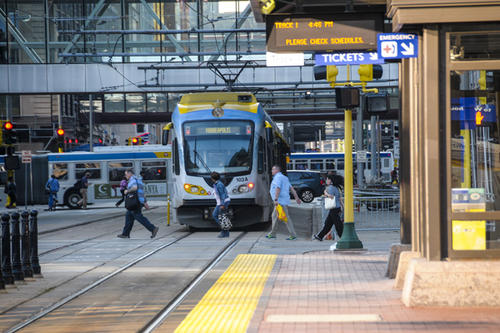
According to the Accessibility Observatory at the University of Minnesota, the Minneapolis–St. Paul metropolitan area ranks 13th nationally in access to jobs by transit, falling from 12th in last year’s rankings. The study reports that the average worker in the Twin Cities metro can reach 16,697 jobs within 30 minutes traveling by transit. Overall, workers in the metro can reach an average of 1.6 percent fewer jobs by transit than a year ago. Total employment in the metro area has remained steady at 1.7 million jobs.
The 1.6 percent decline in Minneapolis–St. Paul is minor and most likely due to changes in the patterns of job and worker locations, said Andrew Owen, director of the Observatory. “New workers to the region who choose to locate in places with little or no transit service will show up as a decrease in average accessibility. The results for the Minneapolis–St. Paul region suggest the pattern of regional population growth, rather than changes in transit service, played the largest role in driving the small decline in average job accessibility by transit.”
The Twin Cities’ ranking decline has more to do with what happened in cities with similar ranks, Owen added.
The annually updated research from the Observatory ranks 49 of the 50 largest (by population) metropolitan areas in the United States for connecting workers with jobs via transit.
The new rankings, part of the Access Across America national pooled-fund study that began in 2013, focus on accessibility, a measure that examines both land use and transportation systems. Accessibility measures how many destinations, such as jobs, can be reached in a given time.
“This new data makes it possible to see the change from year to year in how well a metro area is facilitating access to jobs by transit,” Owen said. “Transit is an essential transportation service for many Americans, and we directly compare the accessibility performance of America’s largest metropolitan areas.”
This year’s report—Access Across America: Transit 2016—presents detailed accessibility values for each of the 49 metropolitan areas, as well as detailed block-level color maps that illustrate the spatial patterns of accessibility within each area.
Key factors affecting the rankings for any metro area include the number of jobs available and where they are located, the availability of transit service, and population size, density, and location. Better coordination of transit service with the location of jobs and housing will improve job accessibility by transit.
The findings have a range of uses and implications. State departments of transportation, metropolitan planning organizations, and transit agencies can apply the evaluations to performance goals related to congestion, reliability, and sustainability. In addition, detailed accessibility evaluation can help in selecting between project alternatives and prioritizing investments.
The research is sponsored by the National Accessibility Evaluation Pooled-Fund Study, a multi-year effort led by the Minnesota Department of Transportation and supported by partners including the Federal Highway Administration and 11 additional state DOTs.
The Accessibility Observatory at the University of Minnesota is the nation's leading resource for the research and application of accessibility-based transportation system evaluation. The Observatory is a program of the Center for Transportation Studies. CTS is a national leader in fostering innovation in transportation.
The Transit 2016 report and other Access Across America research reports for auto, walking, and soon biking, are available at access.umn.edu.
Detailed interactive color maps illustrating the jobs accessible by transit in each metro area are available on the study web page at Access Across America: Transit 2016.
Accessibility Observatory director Andrew Owen is available for an on-camera interview (live shot or tape) via the University of Minnesota ReadyCam® studio, which is remotely controlled by VideoLink professionals and equipped with broadcast lighting, fiber optic and satellite capabilities, and a robotic camera.
- Categories:
- Science and Technology





